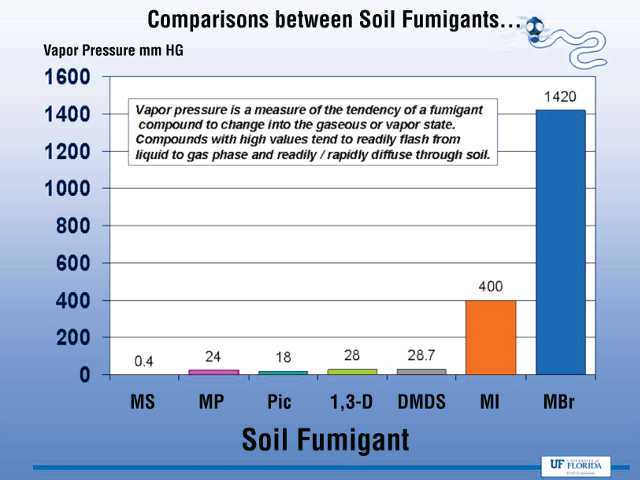Florida Farmers Feeling Pains Of Methyl Bromide Phase-Out

Dr. Joe Noling (right) UF/IFAS walks a field with strawberry grower Dudley Calfee in Floral City, FL. Photo by Mark Wallheiser, FDACS
The phase-out of methyl bromide is taking its toll in many of Florida’s vegetable fields as pests normally controlled well by the fumigant are increasing with every passing season. Dr. Joe Noling, a UF/IFAS nematologist, has been on the front lines working with growers trying to fine tune alternative approaches to managing weeds, nematodes, and diseases now that methyl bromide is gone.
“Methyl bromide raced through soil after application and took no prisoners as it progressed across its destructive path and then left no trace of its presence in five to seven days after application, allowing growers to do what they wanted risk free afterward,” Noling says. “This is why it took 20 years to ultimately phase it out of production and use.”
Vapor Pressure Impact
“All of the alternative fumigants, without exception, have very low vapor pressures compared to methyl bromide, which means they don’t volatilize or move quickly through soil and generally take as much as four times longer (14 to 28 days or longer) to diffuse and dissipate from soil to levels which allow planting,” Noling says. “You don’t always sleep well when you pronounce the field ready for planting. Because they are so much slower, gas and water phase movements have to be factored in as well as application methodologies, which demand different placement, chisel spacing, and rates of application.
“Most importantly, because the alternative products volatilize and diffuse through soil so much more slowly, they are unbelievably vulnerable to environmental events and impacts which occur after application, most notably rainfall, irrigation, and temperature.”
The problems with movement only get worse if it happens to rain after applications or if it gets cool. “In that case, growers are in trouble,” Noling says. “Wet soils inhibit diffusive movement because there are no open air passages for the fumigant gases to move.”
Poor movement of products in the bed sets up problems from the start that will have to be addressed later in the season. “If you don’t kill root-knot nematodes, Fusarium wilt, or nutsedge, they all will increase, requiring action later,” Noling says. “Or, you can expect plants collapsing late in the season right about the first pick or shortly thereafter. This is the inherent and pretty much unavoidable inconsistencies that are incurred, and we must learn how to resolve them. This is the real challenge.”
More: 4 Methyl Bromide Alternatives To Consider
If vulnerability to environmental impact was not enough, growers now cover the bed with VIF and even TIF mulch films, which prolong and almost preclude opportunity for dissipation from the soil.
For growers with good drainage in their fields and in fields not susceptible to flooding, the magnitude of the problem is not as great. “Many times, it is the luck of the draw, having nothing to do with being a great, good, or below average grower,” Noling says. “Mother Nature is dealing the cards.”
Improve Control With Best Practices
Despite the challenges, Noling contends the outlook is good for growers when they follow certain best management practices, including:
- Growers should use only the best quality transplants available, and of a variety which confers as much genetic resistance to principal pests, while maintaining acceptable yield and quality characteristics.
- After final harvest, the crop should be destroyed as quickly as possible to remove food sources for different nematode and disease pests. In most cases, delays in crop destruction contribute to greater pest population increases and more difficulty in achieving nematode and disease control in the subsequent crop. Use of drip fumigation chemicals for crop termination and pest suppression should be considered as a useful IPM tool.
- As an alternative to summer fallowing, crop rotation with a poor or non-host crop is another effective means of reducing soilborne pest and disease populations. It is not used extensively because of the wide host ranges of some of the principal pests in Florida.
- Preplant soil fumigation is generally regarded as the foundation of any IPM program for production of high-value fruits and vegetables in Florida. The preplant fumigant used should be determined after careful consideration and monitoring of the types, incidence, and severity of pest problems occurring in a field. A co-formulation and use of different fumigants are typically recommended to provide adequate soilborne pest, disease, and weed control. Chloropicrin (Dow AgroSciences) usually has proved very effective against diseases and is used as the foundation for disease control. Telone II (1, 3-dichloropropene, Dow AgroSciences) is an excellent nematicide and is generally included in the mix. Since neither Chloropicrin nor Telone perform well enough alone or in combination for weed control, a separately applied herbicide or fumigants like metam sodium (Vapam, AMVAC) or metam potassium (K-Pam, AMVAC) are needed for weed control. Metam sodium and metam potassium can provide good control of weeds when placed properly in the bed. However, research to evaluate the modification of rates, placement, and improved application technology have not resolved all problems of inconsistent pest control.

This bar graph shows the vast difference in vapor pressure between methyl bromide and available alternatives. Image courtesy of UF/IFAS
Dimethyl disulfide, in combination with Chloropicrin and Telone II, is being increasingly used and has demonstrated good to excellent control of nematodes, disease, and weeds when used as a co-formulated product. New strategies are developing to manage odors, outgassing, and offsite movement of field emissions.
Dig Deeper
For more detailed information on managing alternatives to methyl bromide, there are a number of a resources from UF/IFAS online:
- Alternatives To Methyl Bromide Soil Fumigation For Florida Vegetable Production
- Dr. Gary Vallad’s Florida Ag Expo Presentation On Methyl Bromide Alternatives










